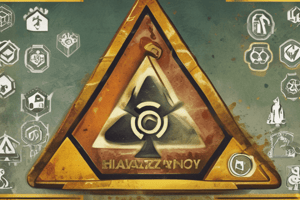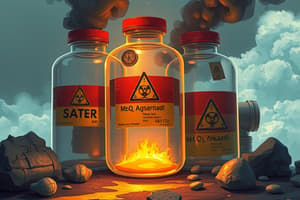Podcast
Questions and Answers
Which section of the Emergency Response Guidebook (ERG) would you consult FIRST to quickly identify the general hazards associated with a hazardous material, given you only know the material's name?
Which section of the Emergency Response Guidebook (ERG) would you consult FIRST to quickly identify the general hazards associated with a hazardous material, given you only know the material's name?
- Yellow Section (United Nations Number of the Substance)
- Orange Section (Page Guide)
- Blue Section (Name of the Substance) (correct)
- Green Part (Isolation Distances)
A first responder arrives at the scene of a chemical spill but only identifies a four-digit UN identification number on a placard. Which section of the Emergency Response Guidebook (ERG) will they consult to determine the immediate next course of action?
A first responder arrives at the scene of a chemical spill but only identifies a four-digit UN identification number on a placard. Which section of the Emergency Response Guidebook (ERG) will they consult to determine the immediate next course of action?
- The Signboard Table
- Yellow Section (United Nations Number of the Substance) (correct)
- Blue Section (Name of the Substance)
- Graphical Charts for Tank and Trailer (ID)
In the Emergency Response Guidebook (ERG), what primary information can be found in the Orange Section to help mitigate risk in an emergency situation?
In the Emergency Response Guidebook (ERG), what primary information can be found in the Orange Section to help mitigate risk in an emergency situation?
- Chemical and physical properties of the substance.
- The substance's United Nations identification number.
- First aid measures.
- Evacuation distances and protective clothing recommendations. (correct)
Why is understanding the 'Graphical Charts for Tank and Trailer' section of the ERG important for first responders at the scene of a hazardous material transportation incident?
Why is understanding the 'Graphical Charts for Tank and Trailer' section of the ERG important for first responders at the scene of a hazardous material transportation incident?
Which of the following resources provides the most comprehensive data about the chemical and physical properties of a wide range of substances, beyond what is offered in the Emergency Response Guidebook (ERG)?
Which of the following resources provides the most comprehensive data about the chemical and physical properties of a wide range of substances, beyond what is offered in the Emergency Response Guidebook (ERG)?
In an emergency situation where a chemical substance cannot be identified and professional assistance is unavailable, which guide number from the provided material should be consulted?
In an emergency situation where a chemical substance cannot be identified and professional assistance is unavailable, which guide number from the provided material should be consulted?
What is the primary purpose of the third column in the first part of the guide?
What is the primary purpose of the third column in the first part of the guide?
You are at the scene of an accident involving a tanker displaying a four-digit number on an orange rectangular panel. According to the guide, what is the FIRST step you should take to identify the chemical substance involved?
You are at the scene of an accident involving a tanker displaying a four-digit number on an orange rectangular panel. According to the guide, what is the FIRST step you should take to identify the chemical substance involved?
Which section of the provided material includes information about chemicals that react with water to produce toxic gases?
Which section of the provided material includes information about chemicals that react with water to produce toxic gases?
If a shipping document for a hazardous material shows the letters 'UN' followed by a four-digit number, where would you FIRST look to identify the substance and find its corresponding preventive guide number?
If a shipping document for a hazardous material shows the letters 'UN' followed by a four-digit number, where would you FIRST look to identify the substance and find its corresponding preventive guide number?
Flashcards
Emergency Response Procedures
Emergency Response Procedures
Actions to take during an accident, including fire (small or large), leaks/spills, and administering first aid.
Initial Isolation and Safe Distances Table
Initial Isolation and Safe Distances Table
A table providing initial isolation and safe distances for protection against hazardous substance incidents.
Chemicals Reacting with Water (Toxic Gases)
Chemicals Reacting with Water (Toxic Gases)
A table containing chemical substances that react with water to produce toxic gases.
Identifying Chemical Substances
Identifying Chemical Substances
Signup and view all the flashcards
Unknown Substance Guide
Unknown Substance Guide
Signup and view all the flashcards
Transportation of Hazardous Chemical Materials Guidelines
Transportation of Hazardous Chemical Materials Guidelines
Signup and view all the flashcards
HAZMAT System
HAZMAT System
Signup and view all the flashcards
Emergency Response Guidebook (ERG)
Emergency Response Guidebook (ERG)
Signup and view all the flashcards
Signboard Table (ERG)
Signboard Table (ERG)
Signup and view all the flashcards
Yellow Section (ERG)
Yellow Section (ERG)
Signup and view all the flashcards
Study Notes
- Guidelines outline prevention methods and personal protection when dealing with hazardous materials.
Guidelines for the Transportation of Hazardous Chemical Materials
- It contains info on 2,500 chemicals identified by their United Nations and Chemical Abstracts Service (CAS) numbers.
- It provides information relating to the chemical substance's properties and how to handle it during transportation and storage.
- This all aims to avoid incidents like fire, leakage, or spillage.
HAZMAT System
- Offers a guide with details on 10,500 chemical substances.
- It includes aspects like chemical and physical properties.
- It contains information on toxicity, firefighting materials, and protective gear.
- It has guidelines for evacuation distances and first aid.
Emergency Response Guidebook (ERG)
- Assists responders in quickly identifying a substance's general hazards.
- Protects first responders and the public during the initial stages of an incident.
Sections of the Emergency Response Guidebook
- Signboard Table- refers to signs used to transport hazardous goods and their respective guide numbers (orange section), consisting of three digits.
- Graphical Charts for Tank and Trailer- illustrates the shapes of transportation vehicles with their respective guide number (orange section), consisting of three digits.
- Yellow Section (ID Number)- Materials arranged by United Nations Identification Number (four digits), followed by the guide number (orange section) and the scientific name.
- Blue Section (Cargo Names)- Materials arranged alphabetically by scientific name, followed by the guide number (orange section) and identification number (four digits).
- Orange Section (Page Guide)- Details potential hazards like fire, explosion, and health effects.
- Green Part (Isolation Distances)- Contains general safety measures for area isolation, protective clothing, and evacuation. It also has emergency response procedures for fire, leakage, and first aid and a table of initial isolation and safety distances.
Instructions for Using the Preventive Guide
- The guide has three parts, including a usage key.
- Each page has five columns
- Column 1: Substance names in alphabetical order.
- Column 2: The UN number for each substance.
- Column 3: The preventive guide number for easy lookup.
- Column 4: Provides the storage guide number and properties.
- Column 5: Displays the hazard ranking per the UN classification.
Identifying Chemical Substances
- Identify using the four-digit number on hazardous warning signs.
- Look for the number on shipping documents or labels.
- Find the substance by name/number in the first part of the guide to get the preventive guide number.
- Open the preventive guide to the corresponding numbering, reading all instructions.
- Search the fourth column for information on the chemical's storage.
- For unidentified substances, refer to Guide Number (1) for professional assistance.
- Class -A explosives should use Protective Guide Number 26
- Class -B explosives should use Protective Guide Number 36
- Class -C explosives should use Protective Guide Number 40
- Blasting Agents should use Protective Guide Number 36
International Chemical Safety Card (ICSC)
- It can accompany hazardous material shipments and available in industrial facilities.
- This document offers information similar to the 2000 Emergency Response Guidebook.
Guidance Sign
- Uses symbols and numbers with specific meanings.
- It needs to be weather-resistant and securely fastened to the transport unit.
- Part (1), which needs to be white, is the warning sign. It indicates the specific hazard of the chemical. like Flammable, Oxidizing, Corrosive, Toxic, or Radioactive.
- The remaining parts are in orange.
- Part (2)- Indicates emergency procedures that must be followed dealing in emergencies
- Part (3)- Indicates the United Nations (UN) number
- Part (4)-Reflects the substance's scientific name
- Guidance sign dimensions: 70 cm length, 40 cm width.
Computerized Chemical Information
- Chemical information is available through computerized systems and programs:
- Early Warning System (Operations)
- the NIOSH Hazardous Substance Program
- CAMEO Program
- Internet search engines
- Computer-Aided Management of Emergency Operations (CAMEO) suite includes:
- CAMEO fm (Database and Information Management Tool)
- CAMEO Chemicals
- MARPLOT
- ALOHA
- CAMEO fm is a database application for emergency planning.
CAMEO Chemicals
- Provides chemical response datasheets and reactivity prediction tools.
- Offers thousands of specific response details.
- Includes:
- Chemical Data- Information on physical/chemical properties, health, air, and water hazards, plus firefighting, first aid, and spill advice.
- UN Data- Response details from the Emergency Response Guidebook and shipping information.
- Assesses hazards of mixing substances.
MARPLOT
- This allows mapping for local response, planning, and operational tasks.
ALOHA
- This atmospheric dispersion model assesses chemical vapor releases.
- Estimates hazardous areas from releases, including toxic gas, fires, and explosions.
Studying That Suits You
Use AI to generate personalized quizzes and flashcards to suit your learning preferences.




